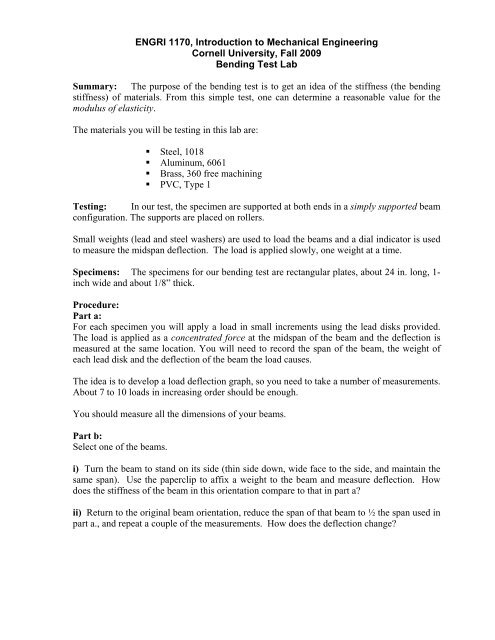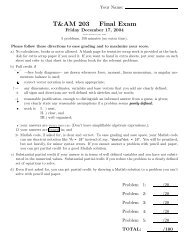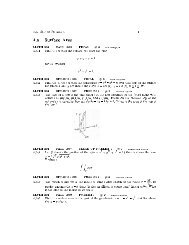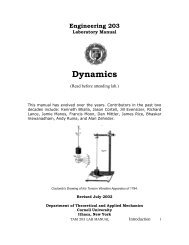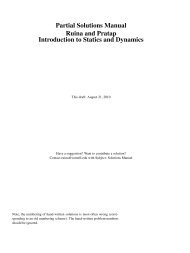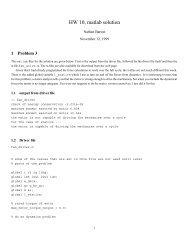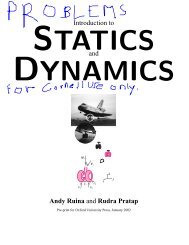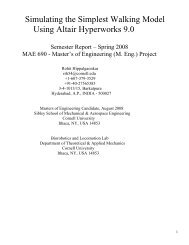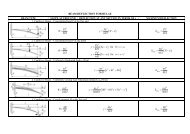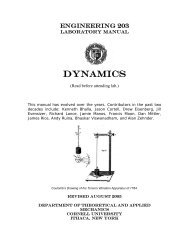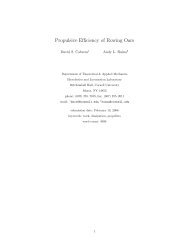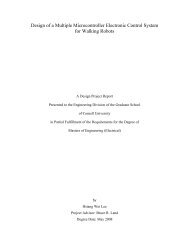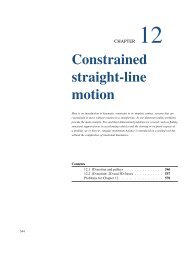Lab 4 Bending Test - Cornell University
Lab 4 Bending Test - Cornell University
Lab 4 Bending Test - Cornell University
- No tags were found...
Create successful ePaper yourself
Turn your PDF publications into a flip-book with our unique Google optimized e-Paper software.
ENGRI 1170, Introduction to Mechanical Engineering<strong>Cornell</strong> <strong>University</strong>, Fall 2009<strong>Bending</strong> <strong>Test</strong> <strong>Lab</strong>Summary: The purpose of the bending test is to get an idea of the stiffness (the bendingstiffness) of materials. From this simple test, one can determine a reasonable value for themodulus of elasticity.The materials you will be testing in this lab are:• Steel, 1018• Aluminum, 6061• Brass, 360 free machining• PVC, Type 1<strong>Test</strong>ing: In our test, the specimen are supported at both ends in a simply supported beamconfiguration. The supports are placed on rollers.Small weights (lead and steel washers) are used to load the beams and a dial indicator is usedto measure the midspan deflection. The load is applied slowly, one weight at a time.Specimens: The specimens for our bending test are rectangular plates, about 24 in. long, 1-inch wide and about 1/8” thick.Procedure:Part a:For each specimen you will apply a load in small increments using the lead disks provided.The load is applied as a concentrated force at the midspan of the beam and the deflection ismeasured at the same location. You will need to record the span of the beam, the weight ofeach lead disk and the deflection of the beam the load causes.The idea is to develop a load deflection graph, so you need to take a number of measurements.About 7 to 10 loads in increasing order should be enough.You should measure all the dimensions of your beams.Part b:Select one of the beams.i) Turn the beam to stand on its side (thin side down, wide face to the side, and maintain thesame span). Use the paperclip to affix a weight to the beam and measure deflection. Howdoes the stiffness of the beam in this orientation compare to that in part a?ii) Return to the original beam orientation, reduce the span of that beam to ½ the span used inpart a., and repeat a couple of the measurements. How does the deflection change?
Results: As you will learn in TAM 2020, the equation relating load, displacement andthe modulus of elasticity for a rectangular beam is:Δ =3PL4Ewt3Where Δ = deflection,P = applied force,L = span of the beam,E = modulus of elasticity,w = width of beam,t = thickness of beam,I = wt 3 /12 = moment of inertia for a rectangular beam.Note: Make sure you use consistent units.Report: Each group will deliver one report that should include:• A brief description of the test procedure, and a sketch of the test setup• Sample calculations and answers to any questions• For each material, use MATLAB to plot (on same graph) the measurements ofload and displacement (those 7 or 10 data points). The slope of the plots is relatedto E.• For each material you need to determine, E, the modulus of elasticity.• The results should be presented in a table format for easy comparison of thematerials tested.Note: Any calculations should have units in every step.


